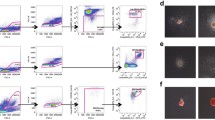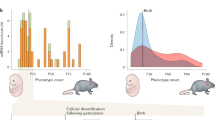Abstract
MicroRNAs are abundant in animal genomes and have been predicted to have important roles in a broad range of gene expression programmes1,2. Despite this prominence, there is a dearth of functional knowledge regarding individual mammalian microRNAs. Using a loss-of-function allele in mice, we report here that the myeloid-specific microRNA-223 (miR-223) negatively regulates progenitor proliferation and granulocyte differentiation and activation. miR-223 (also called Mirn223) mutant mice have an expanded granulocytic compartment resulting from a cell-autonomous increase in the number of granulocyte progenitors. We show that Mef2c, a transcription factor that promotes myeloid progenitor proliferation, is a target of miR-223, and that genetic ablation of Mef2c suppresses progenitor expansion and corrects the neutrophilic phenotype in miR-223 null mice. In addition, granulocytes lacking miR-223 are hypermature, hypersensitive to activating stimuli and display increased fungicidal activity. As a consequence of this neutrophil hyperactivity, miR-223 mutant mice spontaneously develop inflammatory lung pathology and exhibit exaggerated tissue destruction after endotoxin challenge. Our data support a model in which miR-223 acts as a fine-tuner of granulocyte production and the inflammatory response.




Similar content being viewed by others
References
Bartel, D. P. MicroRNAs: genomics, biogenesis, mechanism, and function. Cell 116, 281–297 (2004)
Taganov, K. D., Boldin, M. P. & Baltimore, D. MicroRNAs and immunity: tiny players in a big field. Immunity 26, 133–137 (2007)
Lim, L. P., Glasner, M. E., Yekta, S., Burge, C. B. & Bartel, D. P. Vertebrate microRNA genes. Science 299, 1540 (2003)
Chen, C. Z., Li, L., Lodish, H. F. & Bartel, D. P. MicroRNAs modulate hematopoietic lineage differentiation. Science 303, 83–86 (2004)
Fazi, F. et al. A minicircuitry comprised of microRNA-223 and transcription factors NFI-A and C/EBPα regulates human granulopoiesis. Cell 123, 819–831 (2005)
Fukao, T. et al. An evolutionarily conserved mechanism for microRNA-223 expression revealed by microRNA gene profiling. Cell 129, 617–631 (2007)
Bohinjec, J. Myelokathexis: chronic neutropenia with hyperplastic bone marrow and hypersegmented neutrophils in two siblings. Blut 42, 191–196 (1981)
Lewis, B. P., Burge, C. B. & Bartel, D. P. Conserved seed pairing, often flanked by adenosines, indicates that thousands of human genes are microRNA targets. Cell 120, 15–20 (2005)
Krivtsov, A. V. et al. Transformation from committed progenitor to leukaemia stem cell initiated by MLL-AF9. Nature 442, 818–822 (2006)
Jackson, R. J. & Standart, N. How do microRNAs regulate gene expression? Sci. STKE 2007, re1 (2007)
Vong, L. H., Ragusa, M. J. & Schwarz, J. J. Generation of conditional Mef2cloxP/loxP mice for temporal- and tissue-specific analyses. Genesis 43, 43–48 (2005)
Ernst, M. et al. Constitutive activation of the SRC family kinase Hck results in spontaneous pulmonary inflammation and an enhanced innate immune response. J. Exp. Med. 196, 589–604 (2002)
Yu, C. C. et al. B and T cells are not required for the viable motheaten phenotype. J. Exp. Med. 183, 371–380 (1996)
Bjerknes, R. & Aarskog, D. Priming of human polymorphonuclear neutrophilic leukocytes by insulin-like growth factor I: increased phagocytic capacity, complement receptor expression, degranulation, and oxidative burst. J. Clin. Endocrinol. Metab. 80, 1948–1955 (1995)
Fu, Y. K., Arkins, S., Wang, B. S. & Kelley, K. W. A novel role of growth hormone and insulin-like growth factor-I. Priming neutrophils for superoxide anion secretion. J. Immunol. 146, 1602–1608 (1991)
Inoue, T. et al. Growth hormone and insulin-like growth factor I augment bactericidal capacity of human polymorphonuclear neutrophils. Shock 10, 278–284 (1998)
Li, Q. J. et al. miR-181a is an intrinsic modulator of T cell sensitivity and selection. Cell 129, 147–161 (2007)
Voncken, J. W. et al. Increased neutrophil respiratory burst in bcr-null mutants. Cell 80, 719–728 (1995)
Smith, J. A. Neutrophils, host defense, and inflammation: a double-edged sword. J. Leukoc. Biol. 56, 672–686 (1994)
Malech, H. L. & Gallin, J. I. Current concepts: immunology. Neutrophils in human diseases. N. Engl. J. Med. 317, 687–694 (1987)
Eggan, K. et al. Hybrid vigor, fetal overgrowth, and viability of mice derived by nuclear cloning and tetraploid embryo complementation. Proc. Natl Acad. Sci. USA 98, 6209–6214 (2001)
Clausen, B. E., Burkhardt, C., Reith, W., Renkawitz, R. & Forster, I. Conditional gene targeting in macrophages and granulocytes using LysMcre mice. Transgenic Res. 8, 265–277 (1999)
Camargo, F. D., Green, R., Capetenaki, Y., Jackson, K. A. & Goodell, M. A. Single hematopoietic stem cells generate skeletal muscle through myeloid intermediates. Nature Med. 9, 1520–1527 (2003)
Akashi, K., Traver, D., Miyamoto, T. & Weissman, I. L. A clonogenic common myeloid progenitor that gives rise to all myeloid lineages. Nature 404, 193–197 (2000)
Kondo, M., Weissman, I. L. & Akashi, K. Identification of clonogenic common lymphoid progenitors in mouse bone marrow. Cell 91, 661–672 (1997)
Rothe, G., Emmendorffer, A., Oser, A., Roesler, J. & Valet, G. Flow cytometric measurement of the respiratory burst activity of phagocytes using dihydrorhodamine 123. J. Immunol. Methods 138, 133–135 (1991)
Acknowledgements
We thank D. Bartel and M. Goodell for critical reading of the manuscript, and members of the Bartel and Jaenisch laboratories for discussions. We also thank H. Mulhern, D. Campagna and S. Gokhale for assistance with morphological analysis, and D. Kombe for mouse handling. We are grateful to J. Schwarz for the gift of Mef2c mutant mice. This work was supported by grants from the Whitehead Institute Fellows program.
Author information
Authors and Affiliations
Corresponding author
Supplementary information
Supplementary Information
The file contains Supplementary Figures S1-S10 with Legends. The Supplementary Figures support the general conclusion that miR-223 fine-tunes the process of granulocyte production and activation. (PDF 1190 kb)
Rights and permissions
About this article
Cite this article
Johnnidis, J., Harris, M., Wheeler, R. et al. Regulation of progenitor cell proliferation and granulocyte function by microRNA-223. Nature 451, 1125–1129 (2008). https://doi.org/10.1038/nature06607
Received:
Accepted:
Published:
Issue Date:
DOI: https://doi.org/10.1038/nature06607
- Springer Nature Limited
This article is cited by
-
MicroRNA-223-3p downregulates the inflammatory response in preeclampsia placenta via targeting NLRP3
BMC Pregnancy and Childbirth (2024)
-
Oral administration of a recombinant modified RBD antigen of SARS-CoV-2 as a possible immunostimulant for the care of COVID-19
Microbial Cell Factories (2024)
-
Insight into microRNAs’ involvement in hematopoiesis: current standing point of findings
Stem Cell Research & Therapy (2023)
-
MiR-9-1 controls osteoblastic regulation of lymphopoiesis
Leukemia (2023)
-
Exercise increases MEF2A abundance in rat cardiac muscle by downregulating microRNA-223-5p
Scientific Reports (2023)





